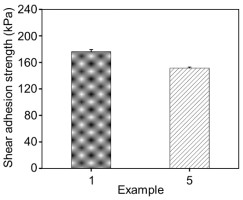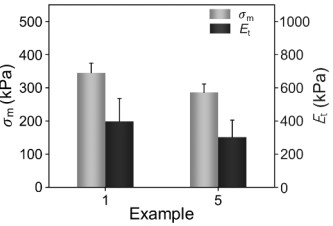First-aid double-bionic gel hemostatic composite material and preparation method thereof
A composite material and gel technology, which is applied in applications, surgical adhesives, medical science, etc., can solve the problems of cumbersome preparation steps, shedding, and unsatisfactory wet tissue adhesion, and achieve strong wet tissue adhesion and promote Effect on tissue healing, rapid hemostasis efficiency
- Summary
- Abstract
- Description
- Claims
- Application Information
AI Technical Summary
Problems solved by technology
Method used
Image
Examples
Embodiment 1
[0036] A preparation method for first-aid double-prevention gel hemostatic composite material, comprising the following steps:
[0037] (1) Dissolve 75.0 mg of phenolic hydroxy chitosan in 9 mL of PBS buffer (0.1mol / L, pH=6.8) to obtain solution A.
[0038] (2) Dissolve 3.0 g of tannic acid in 10.0 mL of distilled water to obtain solution B.
[0039] (3) Dissolve 3.5 g of sodium alginate in 10 mL of distilled water at 45 °C for 2 h to obtain solution C.
[0040] (4) Dissolve 10.0 g silkworm cocoons in 4.0 L 0.02 mol / L Na 2 CO 3 Boil the solution for 20 minutes to remove sericin. Subsequently, the degummed cocoons were fully washed with deionized water, and dried at 60° C. for 3 hours to obtain degummed silk fibroin fibers. 13.5 g of degummed silk fibroin fibers were dissolved in 50.0 mL of 9.3 mol / L lithium bromide solution at 60°C for 4 h. The dissolved solution was put into a dialysis bag with a molecular weight cut off of 3500, and dialyzed with deionized water for 48 ho...
Embodiment 2
[0043] A preparation method for first-aid double-prevention gel hemostatic composite material, comprising the following steps:
[0044] (1) Dissolve 75.0 mg of phenolic hydroxy chitosan in 9 mL of PBS buffer (0.1mol / L, pH=6.8) to obtain solution A.
[0045] (2) Dissolve 3.0 g of tannic acid in 10.0 mL of distilled water to obtain solution B.
[0046] (3) Dissolve 3.5 g of sodium alginate in 10 mL of distilled water at 45 °C for 2 h to obtain solution C.
[0047] (4) Dissolve 10.0 g silkworm cocoons in 4.0 L 0.02 mol / L Na 2 CO 3 Boil the solution for 20 minutes to remove sericin. Subsequently, the degummed cocoons were fully washed with deionized water, and dried at 60° C. for 3 hours to obtain degummed silk fibroin fibers. 13.5 g of degummed silk fibroin fibers were dissolved in 50.0 mL of 9.3 mol / L lithium bromide solution at 60°C for 4 h. The dissolved solution was put into a dialysis bag with a molecular weight cut off of 3500, and dialyzed with deionized water for 48 ...
Embodiment 3
[0050] A preparation method for first-aid double-prevention gel hemostatic composite material, comprising the following steps:
[0051] (1) Dissolve 75.0 mg of phenolic hydroxy chitosan in 9 mL of PBS buffer (0.1mol / L, pH=6.8) to obtain solution A.
[0052] (2) Dissolve 3.0 g of tannic acid in 10.0 mL of distilled water to obtain solution B.
[0053] (3) Dissolve 3.5 g of sodium alginate in 10 mL of distilled water at 45°C for 2 h, then add 20 μL of 1000 ppm nano-silver solution (nano-silver particle size is 10-15 nm), and sonicate for 30 min (sonication temperature 25°C, ultrasonic treatment frequency 40KHZ, ultrasonic treatment power 500W), to obtain solution C.
[0054] (4) Dissolve 10.0 g silkworm cocoons in 4.0 L 0.02 mol / L Na 2 CO 3 Boil in the solution for 20 min to remove sericin. Subsequently, the degummed cocoons were fully washed with deionized water, and dried at 60° C. for 3 hours to obtain degummed silk fibroin fibers. 13.5 g of degummed silk fibroin fibers ...
PUM
| Property | Measurement | Unit |
|---|---|---|
| Particle size | aaaaa | aaaaa |
Abstract
Description
Claims
Application Information
 Login to View More
Login to View More - R&D
- Intellectual Property
- Life Sciences
- Materials
- Tech Scout
- Unparalleled Data Quality
- Higher Quality Content
- 60% Fewer Hallucinations
Browse by: Latest US Patents, China's latest patents, Technical Efficacy Thesaurus, Application Domain, Technology Topic, Popular Technical Reports.
© 2025 PatSnap. All rights reserved.Legal|Privacy policy|Modern Slavery Act Transparency Statement|Sitemap|About US| Contact US: help@patsnap.com



